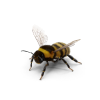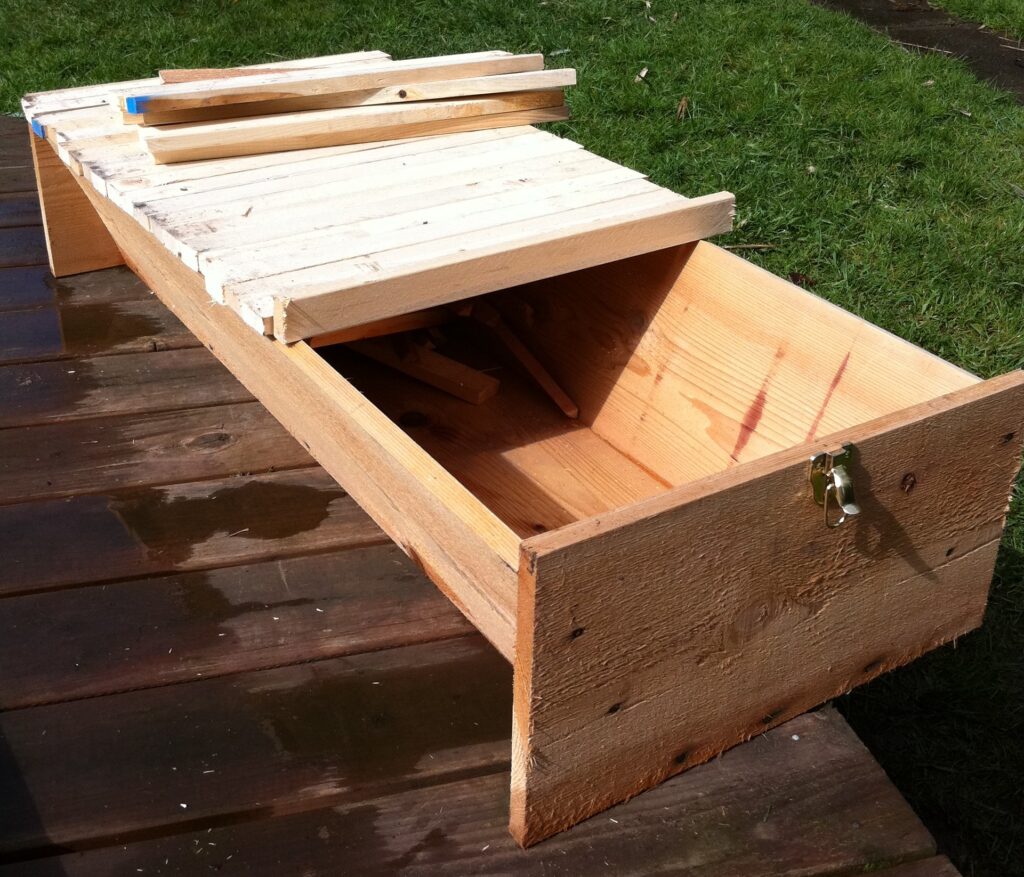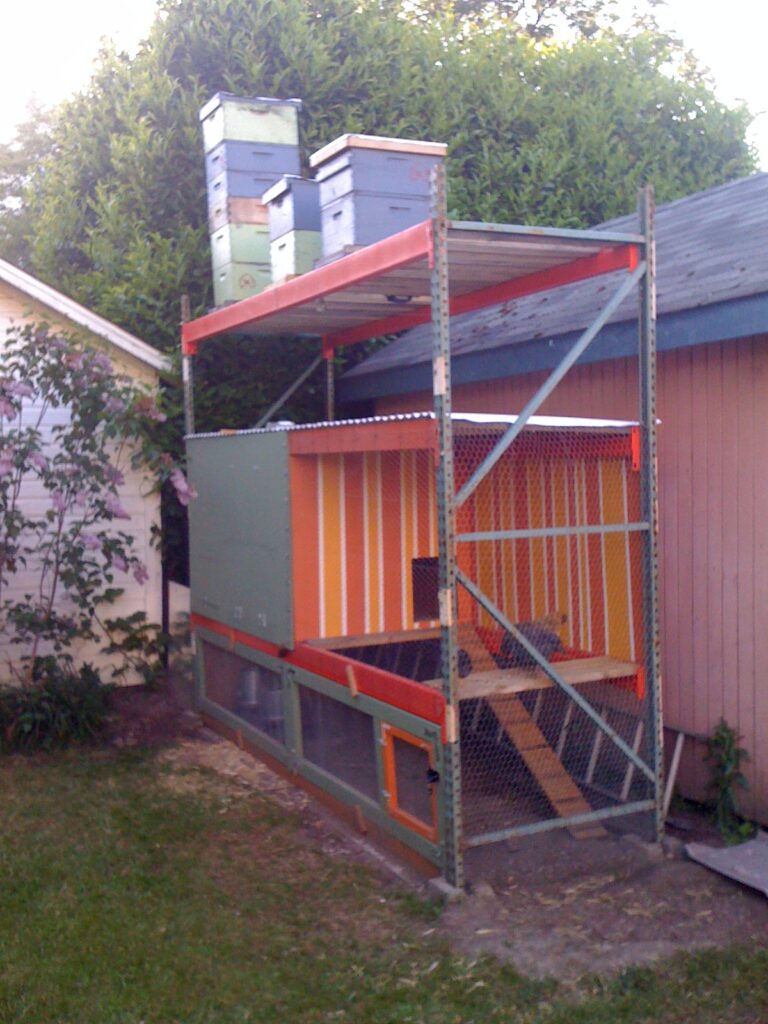Oh, boy, hectic day at the Hive Mind apiary. So, I’m out in my yard Saturday noon, enjoying a cup of coffee and a bit of much needed sunshine, standing by the hives as I am wont to do, when things start to look a little busy. A real lot little busy. Gosh, I says to myself, those busy bees of Hive 1 sure seem to be active today. A real lot active. Good girls! As more and more bees pour out, and the whole yard starts to resemble a humming cloud of bees (see the left-most picture below), I realize that this is more than the results of a balmy Seattle spring, this is a swarm! Egads!
.jpg)
.jpg)
.jpg)
.jpg)
A swarm, for those of you not versed in bee lore is what happens when you have a bad beekeeper. That’s me, bad beekeeper. Bad, beekeeper, bad, bad, bad beekeeper!
OK, it’s not like that, really, bees swarm all the time, even for good beekeepers, but it’s preventable. When a hive gets too crowded, the bees hatch themselves a new queen (just by feeding royal jelly to one of the workers while she’s in her larval stage). Then, at some day and hour timed optimally to screw with my weekend, the old queen exits the hive along with half of the workers, and flies off to establish a new colony, leaving the rest of the hive and the new queen behind to continue making honey and soaking in my hot tub.
That’s nature, that’s how beehives reproduce. Not the hot tub part, the swarming part. Reproduction in hot tubs is exclusively human domain.
Anywa, it’s beautiful that they create new hives, but it’s kind of a bitch for the beekeeper, because it means I lose half of my hive in a single stroke. What a good beekeepers does is make sure the hive has enough room to grow by adding boxes of frames for them to expand into (and fill with honey) and by going through the brood frames on a regular basis to check for (and destroy) queen cells, which are noticeably different than their worker kin in that they are long and bullet shaped to accommodate the extra long body of the queen (see the left and right pictures below for an example).
OK, I am not a good beekeeper, we already established that. I did not add an extra box in time and I did not check for queen cells. So stop with the recriminating looks, already. I feel guilty enough.
Anyway, there they are, a bee river pouring out of the front of the hive. It’s like D-Day, Normandy beach, move it soldier, out out out! I shot a little bit of video of the exodus with my digital Elph, you can get a sense of what it was like.
OK, so snap to action! Go, go, go! Gotta do something!
What the hell do I do? I’m a bad beekeeper, we already established that. Umm…Call Julie! Right, Julie doesn’t know either, but Julie has sense enough to call Jean at Beez Nees Apiary Supply, our ever helpful, ever ornery source of bee wisdom. Yes, Jean said, exasperated, it is not too early for the bees to be swarming. They’ve been swarming since early March, which any responsible beekeeper would have known.
Perhaps Jean could see Julie hanging her head in shame over the phone, because she offered us up some advice. Go through the old hive, make sure you kill all the existing queens cells, and, if you can get the swarm into a box with frames, they’ll set up house and you’ve got yourself a new beehive going.
Again, for those you not versed in bee lore, what happens when the bees swarm is that half the workers follow the queen out in search of a new home. The queen will settle somewhere nearby and the workers will gather around her like a huge fruit. Meanwhile, some of them will then head off to hunt for a location for their new home. As these scouts return, they do a little waggle dance that communicates to the other bees where the potential new home is and what they think of it. So picture a bee wiggling its butt for the other bees saying “I’ve found this place and here’s how you get there and I think it’s pretty neat.” Then other bees will go check out the place described by the waggle dance, and if they like it too, they come back and do the same dance.
So at any given time, there are dozens of these different dances going on between the bees, but the better places get more dancers, because they stick with it rather than switching to a different dance. After a while, they’re all doing the same dance: “I found this place and here’s how you get there and I think it’s pretty neat!” and then the whole swarm rises up en masse in a big black cloud and heads off to set up shop at the neat place.
The key, though, is that where the queen goes, the swarm goes. So, if you can get the queen into a beehive (which is pretty neat), the rest of the swarm will skip the whole dance thing and just assume everybody else already decided this is the place, and they’ll settle in.
I’m off and running! I throw on a long sleeve shirt and pants, a veil and some gloves and rip open the old hive. It’s pretty safe work managing the bees at this point, because when they’re swarming, they’re at their most docile, for some reason. Something about having gorged themselves on honey for the trip.
Still, it’s hard, back-breaking work. The boxes are laden full with honey, weighing in around 40 or 50 pounds apiece, and I have to heft them all about, then pull out each frame individually and check for queen cells. If I find one, I gouge my gloved hand into it, killing the larva inside. Visions of the Russian Revolution race through my head, young Anastasia wakened to the sound of rioting and the glow of torches outside her window. “Quickly Princess, you must run, for the peasants are killing all who would be queen!” That, or the end of the Godfather, where Michael Corleone calmly attends his son’s baptism while his goons execute all his would-be rivals in a single, bloody massacre.
The queens are cleared out, the hive looks healthy otherwise, and I grab a frame of brood out to seed into the new hive to give them a jump start on their new enterprise. If you brush off all the bees that are on it and put it in, the bees will raise them as their own (which, in this case, they actually are) and it will provide some shock troops while the queen gets settled and starts laying new brood in the the new hive.
Now, it’s time to catch the swarm. They’ve apparently settled on a neighbor’s fence, which is a bit of a pain because they’re mostly on the backside of it, meaning I’m going to have to crawl in through the bushes to get at them. Julie arrives now, just in the nick of time, to help. She suits up quick, and, after a brief panic attack brought on by the buzzing swarm and the overly enthusiastic co-apiarist (read: me), she calms down and we get to work.
When I opened up Hive 2, which I thought was dead, I actually found there were a few stragglers there, along 5 or 6 cells of drone (male) brood, which is all workers can lay in the absence of a queen. Sorry, Charlies, time to move. Here I felt a bit like European settlers arriving on debilitated and decimated Easter Island, the last remnants of a dying people wiped aside to make way for a new civilization.
OK, I’m stretching it here. The Russian Revolution analogy was pretty good, though, don’t you think? “Why, why do they want to kill me?” she cried. “Because you could be queen!”
Anyway, we cleared what was left out of hive 2 and decided to use it as the new home for the swarm. There was quite a bit of mold on the frames, as there hadn’t been enough of a hive to take proper care of it, but I didn’t have much choice. That or nothing.
So I shimmy in between the bushes and the fence while Julie holds the box against the fence under the swarm (arm’s length, just the tips of her fingers touching, as if the box itself might sting her if she isn’t careful). I gently massage the bees through and they fall like an overripe fruit, plunk, into the box. Quickly, we pop the top back on, carry it back to where the hives sit, set it down and we’re done!
.jpg)
.jpg)
.jpg)
.jpg)
I thought.
I figured we had ’em for sure. We went back and checked where they had been and there were just a few stragglers left. No worry, the girls, once they’ve established the new hive, will stick their stinky little butts in the air and beat their wings, sending pheromone signals to the wind calling the strays home. We stuck in a few bottles of sugar syrup with Nosema that I had left over from last month and called it a day.
I did notice, after I had cleaned up and was getting ready to go to an art planning meeting for my Burning Man group, the Space Virgins, that there was a fairly large clump of bees hanging out under the pallette that the hives sit on. You can actually see them in the right-most picture above, just by leg.
Hmm…a fairly large clump. Wasn’t quite sure what to make of that, actually. Ah well, they must be either part of the new hive or the old hive, and either way, they’ll eventually make their way back in, because both hives are right there. Off I went.
So I wake up this morning (Sunday), and go out to see what’s going on.
Big clump, still there.
Really big clump. Like, hive-sized clump. There must be 10,000 or so bees there.
Shit.
That could be another swarm, or maybe it’s the original swarm and I didn’t get them and they’re still wondering where to settle. Goddamn.
So I grab a glove and a old plastic sorbet container and head out to try to gather them in. I’m emboldened by their docility yesterday, so I’m working in shorts and t-shirt, slippers, no veil. I pop the top off of Hive 2 (the new hive), reach under the pallette and, with my gloved hand, and push a load of them into the sorbet container.
They’re pissed. Ow! Goddamnit, I got stung! Ow ow ow!
OK, I kinda had that coming. I mean, I should have worn gloves, not just a glove. Anway, I dump a sorbet container of bees into the new hive, dance about the yard holding my aching wrist, grab a second glove and head back to get another container full.
This time, I reach under, shove a load in, jet around to dump them into the hive and what do I see, clinging to my glove? A queen! The old queen! There she is, big and golden and shiny and sportin’ a green dot on her back (purchased queens come with a dab of paint on them to help bad, bad beekeepers such as me distinguish them from their peasant sisters).
Victory! I shake her into the hive, dump the rest of the sorbet container of bees with her, and seal it up.
So that leaves a few questions. What did I catch yesterday? Was it a double swarm? Do bees do that? If so, what happens now? Did I just catch some random bees who were doing some scouting? Was the queen with them, but then she left the hive because it was too moldy (in which, she’s likely to leave again)?
I dunno. We’ll see, I guess.


.jpg)
.jpg)
.jpg)
.jpg)
.jpg)



